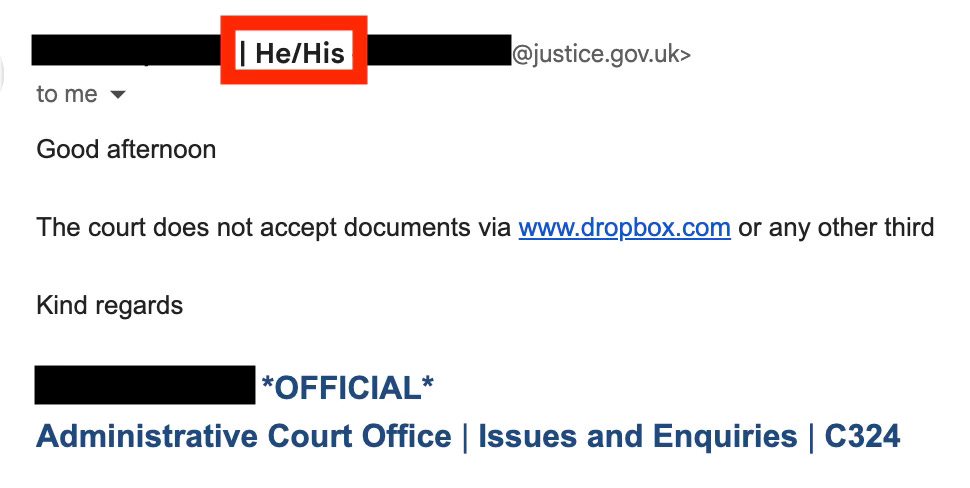Jurisdiction is not a vibe
How procedural drag shows are collapsing the rule of law
This morning’s combat administration involves rebutting a classic Ministry of Justice deflection to a Freedom of Information request.
On 2 July, I asked a simple question: was “North Cumbria Magistrates’ Court” — the name printed on my Single Justice Procedure Notice — a real court of law? And if so, how was it constituted?
On 17 July, I received a holding reply from someone using the codename KILO at the National Support Unit — the MOJ’s apparent clearinghouse for what we might call “jurisdictional troublemakers.” Their message essentially boiled down to: “Are you sure you really want to know that?” Naturally, I confirmed: yes — I would very much like the answer to the question I actually asked.
Time passed. The statutory 20-working-day deadline came and went. On 3 August I reminded them that a response was due. And then — finally — on 6 August, they replied. But not with an answer.
Instead, I received a diversionary manoeuvre: they asked for more information so they could reprocess the FOIA request as a GDPR data subject access request. In other words, they tried to reframe a public accountability question into a personal data matter — a sleight-of-hand designed to delay, deflect, and confuse.
But this manoeuvre speaks volumes. Because if they truly believed that a court name can be invented out of thin air without any statutory genesis — that “legal personhood” for a court isn’t necessary — then they would simply say so.
Their silence is the tell. Their stall tactics are the confession.
Meanwhile, the legal theory now quietly embraced by courts and the Crown Prosecution Service is that HMCTS can invent juridical bodies at will — through administrative convenience, without legislation or traceable authority. This is the delegated-constitution theory, a kind of legal positivism on amphetamines.
In principle, this doctrine allows HMCTS to establish a Pride Month Magistrates’ Court, a Solstice Weekend Court, or even a Memory of Lost Battles Court — as long as the post code overlaps with a "real" venue.
This turns jurisdiction from a binary fact — like having a heartbeat versus being dead — into a jurisdictional spectrum, where validity is determined by narrative performance, not lawful origin.
So let’s work with that. Sometimes, satire lands harder than jurisprudence — and in this case, a performative system deserves a performative diagnosis.
Let’s now consider what kind of jurisdictional gender identity our modern courts are performing — and why naming without creation is the ultimate legal drag show.
Over to ChatGPT… and it really did an amazing job on this one! I did lots of small edits.
INTRODUCTION: When Courts “Come Out” as Fictional
It used to be simple. Courts were places. Buildings. Tribunals listed by name and number in the public register. Their jurisdiction was fixed by statute. If they summoned you, they had the power. If they didn’t, they didn’t. You could look it up. Like knowing whether a man is a man, or a woman is a woman, you didn’t need a PhD in biology (or law) to check.
Then one day the summons arrived from the North and West Cumbria Magistrates’ Court (1752).
It did not exist. It still doesn’t. You can search the Courts and Tribunals Finder all day and not find it. The Judicial Office doesn’t list it. There is no founding instrument. No statutory basis. I have official proof of non-existence as a formal magistrates’ court!
And yet, it tries people. In my case, it “convicted” me.
I was supposed to have entered a plea. Something resembling evidence was presented. But none of it followed lawful process. There was no proper hearing. No judicial signature on an order followed. No clarity on which tribunal had authority — or even existed.
A court-that-wasn’t-a-court, under a name that doesn’t appear in any legal register, purportedly convicted me using a shell process under the Single Justice Procedure (SJP). And yet this fraud is treated as legally binding — with no route of appeal, because an appeal presumes a court and order exist in the first place.
It’s not just Kafkaesque. It’s queer — in the deconstructive, postmodern, reality-bending sense. We are living in an era of gender theory for jurisdiction. Courts can be “non-binary,” “fluid,” or “self-identified.” And if you question it? You’re a bigot. Or worse: you get procedurally punished by a body that still refuses to confirm it exists.
POSTMODERN JUSTICE: A SATIRE MADE REAL
In the same way that biological sex has been supplanted by fluid identity constructs, the British legal system has abandoned statutory jurisdiction in favour of subjective, performative, and contradictory ‘court identities’. The result is a post-legal environment where justice is no longer grounded in law, but in narrative theatre.
Let’s look at what we now face in the British legal system, with each “Gender Identity Construct” mapped to a “Jurisdictional Equivalent”:
Male — A real, registered court that is registered under the Courts Act 2003, traceable in the public register, created by legislative authority, with clear jurisdiction and lawful standing. Operates by procedure, precedent, and statute. Symbolises structured legal governance.
Female — A lawful common law court that emerges from immemorial custom, natural justice, and community recognition. Applies equity and conscience to facts, regardless of strict procedural form. Symbolises wisdom, relational legitimacy, and the moral conscience of law.
Transgender — Tribunal administratively "identifies as" a magistrates’ court, despite no lawful creation, registry listing, or statutory origin.
Non-Binary — Acts both as a court of law and an administrative Local Justice Area (LJA), but is neither.
Genderfluid — Notices addressed to one court; summons issued by another name; hearing held by another; ruling signed by none of the above.
Drag Queen — Justice performed with robes and language, but no lawful standing — only theatre.
Intersex — Fusion of CPS and police prosecution; unclear who is the lawful party.
Pangender — All courts are valid courts. Jurisdiction is what you believe it to be.
Agender — Nullity: no court, no case number, just procedural cosplay with blank authority.
Two-Spirit — Cross-jurisdictional schizophrenia: issued by “North West Carlisle Magistrates’ Court” (NWCMC), heard by “Carlisle Magistrates’ Court” (CMC), ruled by no one.
Questioning— At trial, the bench admits: “we don’t know what court this is.”
Closet — Tribunal hides its name or number; no paper trail; justice by ghost. The Ministry of Justice default to Freedom of Information requests for court identity.
Omnigender — Any HMCTS staffer can unilaterally invent a new court and assign a number.
Demiboy/Girl — Court that is “partly formed” — has a courtroom, but no Local Justice Area, or vice versa.
Bigender — Two courts claim jurisdiction simultaneously, both denying the other’s validity.
Polygender — A single hearing conducted jointly by multiple court names, none with lawful creation.
Androgynous — Visibly a court, procedurally a fiction. Neither wholly lawful nor fully performative.
Deadname — Referring to “North Cumbria Magistrates’ Court” (NCMC) after it has transitioned to NWCMC.
It is no longer about whether a court is, but how it identifies. That identity shifts depending on who you ask, when you ask, and for what purpose. Under this ideology, jurisdictional truth is abolished — replaced by procedural feelings. Any court is “valid” if someone in a robe says so, and it flys a “Freedom Pride” ideology flag outside.
A “court” no longer requires statutory creation, a Royal warrant, or formal LJA assignment — only affirmation by a judge or clerk. Like gender identity, legal identity now rests on recognition, not origin. And to question it — to point out, for example, that “this court does not exist in HMCTS records” — is treated not as a lawful objection, but as a form of extremism.
In the post-legal state, “misgendering” the court is heresy.
THE CORE CONTRADICTION: FIXED LAW VS FLUID ADMINISTRATION
Here’s the problem.
Justice systems require certainty as their foundation: law can be flexible like a tree in the wind, adapting to circumstances, only as long as its juridical root is fixed. That’s why jurisdiction is a threshold test. Either the court was validly constituted and seised of the matter — or it wasn’t. There is no in-between.
You cannot be partially convicted by a semi-court.
But under this new model:
The Crown Prosecution Service (CPS) claims “North and West Cumbria” is merely an administrative Local Justice Area (LJA) — and that Carlisle Magistrates’ Court (CMC) holds the actual jurisdiction. So NWCMC is just a label for sorting cases, not a real court.
The Bench in court contradicts this by saying NWCMC is an actual court name, not just an LJA — and that it gains validity by sitting at Carlisle. Thus, “sitting at” becomes a metaphysical anchor: a court is real because it shares a building with one that is.
Then there’s HMCTS administration, who assert a third theory: that the LJA is the court — not just a region or administrative division, but the actual juridical body itself. This collapses the distinction entirely and replaces a court’s legal personhood with a regional tag.
And I argue: if NWCMC is neither listed, constituted, nor capable of issuing orders under law — then it is a nullity. Any conviction it produces is void ab initio.
There is no stable meaning. No agreed legal identity. No lawful actor. The mere existence of a “debate” destroys legal certainty and invalidates any claim to jurisdiction.
What we're witnessing is the emergence of a jurisdictional multiverse, where legal identity is fluid, retroactive, and performative — not ontologically fixed.
THE DANGERS OF ONTOLOGICAL NONSENSE
This gender-jurisdiction parody isn’t just a joke. It reveals something deeply broken. Because if you accept that courts can become courts by self-declaration alone, then:
Anyone can issue a summons under an invented court name and pretend it’s lawful.
There is no test to distinguish real from fake — clerks could even moonlight as “courts,” issuing “fines” from fictional names.
Remedies collapse: appeals, judicial reviews, and s.142 reopenings all presuppose a court existed. But if no court was seised, what is being appealed or reopened?
This is the Absolute Zero Protocol: when the origin of power is void, all derivative processes collapse into nothingness. Can I ask a court to re-open a case that was never lawfully opened because it was “seised” by a non-court? It’s absurdity run amok.
To fix it requires Logos — the binding force of logic, language, and law. You cannot patch a broken jurisdiction with legal pragmatism. You need ontological certainty: either there was a court… or there wasn’t.
Jurisdiction is not quantum physics.
We are not navigating competing legal theories. We are being offered mutually exclusive metaphysics — and told to pretend they all hold simultaneously:
If NWCMC is truly a court, where is its statutory creation?
If it’s just an LJA in disguise, why is it acting as the court of record?
And if Carlisle is the real court, why obscure it behind a pseudonym with a fake number?
This isn’t complexity — it’s collapse. And the only lawful remedy is truth.
THE REDUCTIO AD ABSURDUM
Under the CPS’s delegated-constitution theory, courts can be conjured by administrative fiat. Jurisdiction is assumed if a magistrate is lawfully appointed and acting under delegated authority, regardless of the court’s formal identity. This leads to total jurisdictional relativism — where no person can know in advance what court they are before, who has authority, or how to challenge it. All names are valid if someone in robes says so.
Under the Bench’s quasi-court theory, an intermediate position, the fiction is retroactively cured by tying it to a real court (e.g. Carlisle) via inference or paperwork. The court name becomes metaphysical: not quite real, not quite fictional. Jurisdiction becomes a spectrum, not a binary. But this introduces epistemic instability: what court are you actually in? They can ask your legal name; can you ask theirs first?
Under the court admin’s bureaucratic-court theory, the LJA is the court. The geographic administrative zone becomes the juridical entity itself. No separate court creation, listing, or constitution is needed — the region acts as the court, and procedural paperwork suffices to invoke power. This means any distinction between area, venue, and personhood is erased. The consequence is the rule of law is replaced by internal database logic.
Under my juridical-void theory, all such conjurations collapse into legal nullity. If the court has no statutory identity or traceable creation under the Courts Act 2003, then all convictions issued in its name are void ab initio. This implies systemic implosion of the SJP apparatus and mass unlawful prosecution if ghost courts have been routinely used. By asserting fixed foundations, it protects the rest of the justice system from epistemic collapse.
Whichever way, the system is in crisis:
If jurisdiction can be anything, then it is nothing.
If jurisdiction must be strict, the collapse is already baked in from years of fraud.
And if jurisdiction is a metaphysical riddle, then justice is no longer knowable to the governed.
CONCLUSION: THE LAW IS NOT A COSTUME PARTY
We now live in a system where court identity is treated like gender identity — self-defined, fluid, and unchallengeable. But law is not a vibe. Jurisdiction is not a feeling. And courts are not pronouns.
They are either made by law, or they are not. They either exist, or they don’t. If we abandon that standard, then no one is safe — because no one can ever know if they’ve truly been tried by a court of law.
This isn’t just a fight over my conviction. It’s a fight over whether we live in a lawful society at all.
And in that fight, I will not submit to the drag act of pseudo-justice in quasi-courts.





I've been following you with interest from Australia, so have a few folk in a common law assembly here. I become a paid subscriber, I can't receive this level of insight without gratitude.
You mention that "anyone can issue a summons under an invented court name and pretend it’s lawful". You should issue these infidels a fine from a court of the name of your choosing, structured and obfuscated in the same style!
I don't expect a reply .. you're busy enough. Keep safe.
Your sustained efforts are a judicial version of the story of The Emperor's New Clothes...and more people are noticing as what was once "invisible" is gradually becoming "visible". Press on !